When seconds matter
By Ethan Smith
Published in News on February 10, 2017 9:34 AM
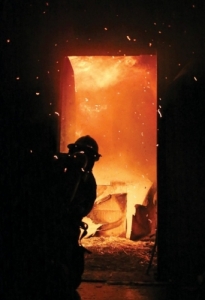
News-Argus/CASEY MOZINGO
A firefighter checks on the progress of a fire that was ignited during a training exercise Thursday. Flames to cover the floor and ceiling as smoke begins to fill the room top to bottom and spill out into the rest of the training facility. Staying low in a burning building keeps a victim away from the smoke and heat from a fire until they can escape or be rescued.
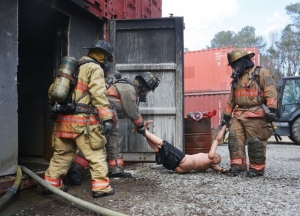
News-Argus/CASEY MOZINGO
Firefighters with the Goldsboro Fire Department rescue a dummy from a fire in the training building Thursday during an exercise to teach search and rescue and hose line work lead by a group from the Fire Department Training Network.
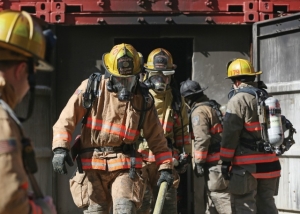
News-Argus/CASEY MOZINGO
Firefighters with the Goldsboro Fire Department pull out hose from the training building Thursday during an exercise to teach search and rescue and hose line work lead by a group from the Fire Department Training Network.
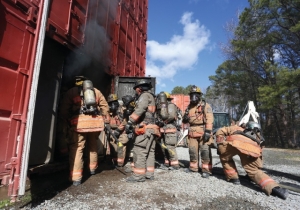
News-Argus/CASEY MOZINGO
Firefighters with the Goldsboro Fire Department make their way into the training building Thursday during an exercise to teach search and rescue and hose line work lead by a group from the Fire Department Training Network.

News-Argus/CASEY MOZINGO
Jim McCormack, right, speaks to a group of firefighters from the Goldsboro Fire Department Thursday before their training exercise. McCormack and two other instructors from the Fire Department Training Network lead a three day course at the training grounds off of U.S. Hwy. 117.
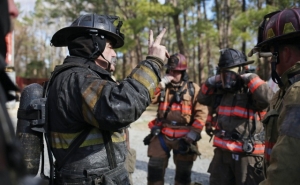
News-Argus/CASEY MOZINGO
Mike Lombardo, right, gives instruction to a group of firefighters from the Goldsboro Fire Department Thursday before their training exercise. Lombardo and two other instructors from the Fire Department Training Network lead a three day course at the training grounds off of U.S. Hwy. 117.
What feels like ages is truly a matter of minutes as flames burn whatever is in their path and the thermal layer bears down on whoever is inside the home.
Even after firefighters arrive on scene, the difference between life and death can be decided in seconds.
Approximately 3,400 Americans die in fires every year -- 85 percent of those deaths come from house fires -- it takes work to keep that number as low as possible.
And lots of practice.
That's exactly what the Goldsboro Fire Department was up to this week ---- a three-day training session that culminated Thursday at the department's training grounds off of U.S. 117.
"If they do this now, and they get it 45 seconds to a minute faster, that can be the difference between, 'Man, there was a terrible fire at my house the other day,' and, 'Hey, we're burying (someone) today," said instructor Mike Lombardo from Buffalo, New York.
Approximately 24 firefighters from the Goldsboro Fire Department participated in the training, learning skills such as hose-stretching, forcible entry, roof ventilation, controlling and extinguishing the fire and rescuing victims.
Thursday's exercise brought the three-day training course to a head, with firefighters running an exercise that required them to force entry into a two-story structure, search for victims on two different floors, control the fire, extricate the victims inside and extinguish the fire -- all at the same time.
"You've got 10 to 15 people inside at one time in thick smoke and flames all trying to do what they need to do and they can't really see each other," said instructor Jim McCormack, from Indianapolis, Indiana.
Firefighters entered Conex boxes --large shipping containers welded together to simulate buildings with complete interiors -- at the training grounds to rescue adult and child dummies after instructors lit a fire inside using hay bales and pallets.
This simulates a real-life situation where lives are on the line, the instructors said.
Lombardo said the majority of the more than 3,000 fire deaths per year happen during house fires, with people dying one or two at a time, and that mass-causality situations because of fires are rare.
Honing response times and the skills required to evacuate people from structures while extinguishing the fire as rapidly as possible is paramount, he said.
The training facility was built in 2015 using Conex boxes formed into structures. It cost less than $100,000 to bring it to fruition, and officials estimate it could have cost upward of $2.5 million anywhere else.
"That's mind-boggling," Lombardo said.
Lombardo and McCormack are part of a fire department training outfit out of Indianapolis called Fire Department Training Network.
The firefighters that built the training grounds, where Lombardo and McCormack came to teach this week, learned how to do it from the Indiana-based organization.
Capt. Lisa Johnson of the Goldsboro Fire Department said the skills learned this week by participants will help keep their skills sharp to carry into real situations that develop throughout the city.
